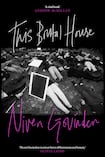
This Brutal House, Niven Govinden’s fifth novel, begins with an act of protest. Gathered on the steps of New York’s City Hall, five drag Mothers (the heads of five drag families) sit in a silent, textless protest. The Mothers, who act as the guardians and stewards of a queer community, offering both love and accommodation, have come to pray. Their children have been going missing, and no-one is taking notice. These drag families, “drawn together by the air of absence that framed us”, are fierce, and have learnt how to channel their anger.
This vibrant novel is, among other things, about the many ways in which the force of that anger becomes emancipatory. In a time of greater mainstream visibility for drag culture - not only through RuPaul’s Drag Race, but through series such as Pose (currently airing on the BBC), live performance, and literature (think of Joseph Cassara’s House of Impossible Beauties) - Govinden’s gift is to explore the complex and disruptive modes of queerness.
If the novel’s opening pages are a little slow, it is because The Brutal House is cumulative, and requires a building of energy, which is released in vital bursts. Unlike some TV representations of drag culture, Govinden also gives us the terror of oppression, and the violence that drag builds itself in opposition to. Recalling looking after Sherry - a queen who has gone missing - the Mothers tell us that “in doing this, we are healing ourselves”.
When her face is bruised from taking home the wrong trick, who steals our VCR and other electronics after he is satisfied he has beaten her enough, f**cked her enough, we bathe and change her as gently as if she were a baby; the intruder’s scent static in the air - sweat and spunk - clinging to our walls and furniture for weeks afterwards.
Precarious position
Acerbic, encompassing, funny, and mounting towards the spiritual, Govinden’s book shows the complexity of drag balls and queer life. On the other side of the Mother’s protest is Teddy - a man raised by the Mothers, and now working as a clerk in City Hall. Tasked with brokering a sort of peace between the protesters and the authorities, Teddy is placed in a precarious position. Tracing his journey through the drag family, his experiences of class, gender, and the various other identities that drag subverts, This Brutal House is a novel of interfaces. However, as in the opening sequence, where the Mothers refuse to translate their anger for the authorities, Govinden’s book does not decode itself for its readership; rather, it submerges them in the language of its subject.
“Are you taking this down? It must be transcribed to the very letter. Don’t be tempted to make it pretty. We’ve tried doing it in your language and they ignored us. Forced us into their drag, only to be patronised and belittled in their space. No more. Time to give them a taste of ours. Real talk.”
This is a world full of codes and signifiers, concealed double-meanings, hidden texts and playful language. It exists aslant from the world of police and government, and its elaborate fashions and dances are deeply political. In the chapters dedicated to the interjections of the vogue caller during the balls, Novinden plays with the concept of “realness”, a fundamental mode of drag in which the person walking any given category is deemed to embody the likeness (both in dress and attitude) of that category. Examples might be “executive realness” or “soccer mom realness”.
Vogue caller
But for Govinden, these are turned outwards, becoming a commentary on drag in all its emancipatory and political forms. The vogue caller shouts over the narrative:
“Category is: Saturday night at the plantation realness. Category is: river fugitive realness. Category is: Freetown realness. […]Category is: suffragette city realness. Category is: femme emancipation realness. Category is: marching for your rights realness. Category is: bravery in drags realness. Category is: uncompromising bitch realness.”
The drag hall, in This Brutal House, is a sort of church and sanctuary, a community of the oppressed rising in celebration: “a luminescence… ethereal and without a place on this earth, bar this space, this home”. “Voguing,” Govinden tells us, “is like communing with spirits”. This is an important, and in places an experimental book, full of spark and wisdom. Its tone is in place elegiac, in others vibrant. Like the best drag acts, This Brutal House leaves its reader full of a powerful, protesting energy. As the vogue caller shouts: “Walk. Walk. Walk. Walk. Walk. Walk. Walk. Walk. Walk. Walk. Pray your maker sees you. Walk”.










